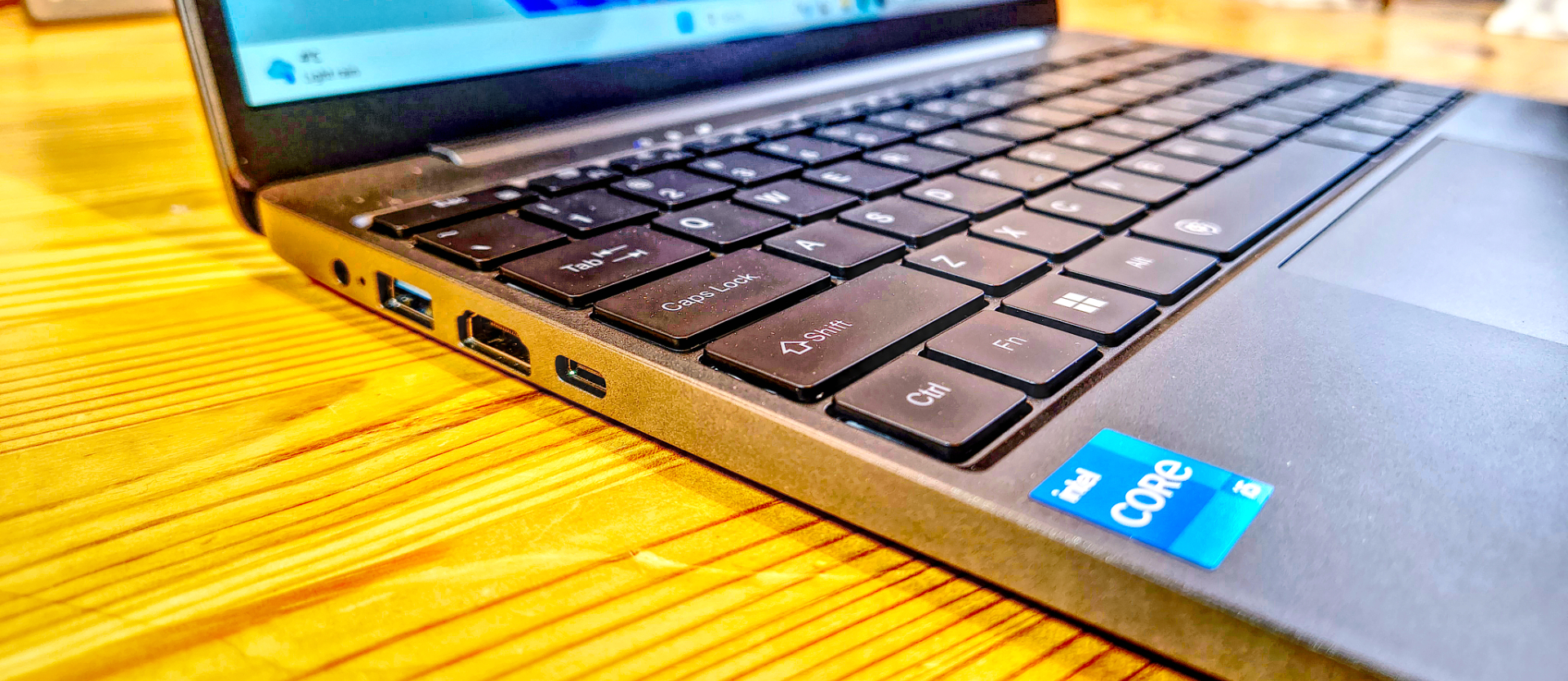TechRadar Verdict
This platform appears to have been stymied by Intel before it was even made. With no USB 3.2 ports or Thunderbolt ports and poor battery life, I have difficulty recommending this for frontline use.
Pros
- +
Nicely engineered
- +
Inexpensive
- +
High-resolution screen
Cons
- -
Limited battery life
- -
Lacks biometric security
- -
No USB 3.2 Gen 2 ports
- -
Wasted PCIe lanes
- -
Limited availability
Why you can trust TechRadar
Chuwi CoreBook X: 30-second review
Chuwi is a Chinese manufacturer that entered the market in 2014, first with a selection of Android tablets and then diversifying into laptops and mini PCs.
The CoreBook X is typical of inexpensive Chinese laptops that are surprisingly well-engineered, using Intel, which is a few steps removed from cutting-edge processor technology.
The model reviewed here uses a 12th-generation Intel Core i5 mobile processor that first appeared in January 2022. It comes with 16GB of DDR4 memory, 512GB of storage, and a 14-inch 1440p resolution display. Chuwi also claims it covers 100% sRGB color gamut, which puts it on par with some of the best laptops for photo editing, but at a budget price.
It lacks an easy means to upgrade the storage or any USB ports better than USB 3.2 Gen 1 (old USB 3.0). It also uses an older GPU technology, and it lacks any biometric access control.
Therefore, that’s an old and somewhat tired specification out of the box, even if the quality of the build is high and plenty of metal is used in its construction.
The big selling point is that it costs less than $400, but the battery won’t last a full working day and transferring files to external SSDs will be relatively slow.
If you have a modest budget and requirements, then the CoreBook X might work for you, but a low-cost AMD Ryzen laptop might deliver a better experience.
Chuwi CoreBook X: Price and availability
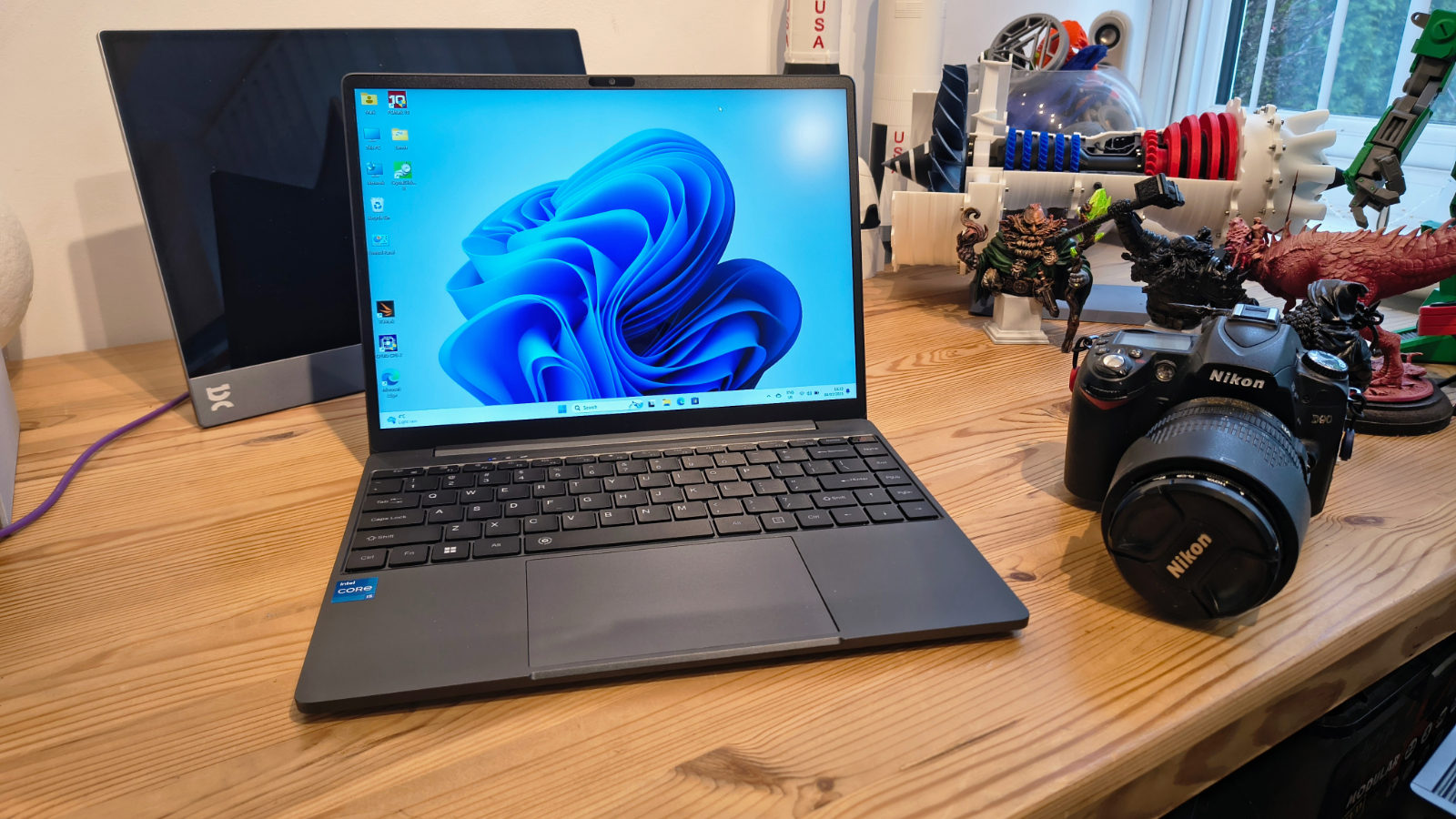
- How much does it cost? From $370/£320/€358
- When is it out? Available now
- Where can you get it? Direct from Chuwi
Something is odd about the availability of the CoreBook X that makes me wonder if it’s a limited run, possibly using a limited supply of the older Intel processors that have been made available.
While most Chuwi models appear on all the regional Chuwi sites and on Amazon in most regions, the CoreBook X is only available on the global outlet.
There are currently four CoreBook X SKUs, with one using the i3-1220P CPU, two using the i5-12450H, and one using the i5-1235U.
The two i5-1245H models are a standard CoreBook X that’s the review hardware, and Chuwi also makes a CoreBook XPro option with an even bigger 15.6-inch display, and slightly more battery capacity.
The i3 model starts at $369, and the i5-12450 is $399 in the USA. They are €357.20 and €386.24 in Europe and £297.51 or £321.69 in the UK.
For those interested, the CoreBook XPro is $429/€415.28/£345.88, and I couldn’t find the i5-1235U model in the Chuwi store.
Typically, Intel Core i5 laptops start at around $500, like the Acer Aspire 5 15 Slim Laptop. But these can use DDR5 memory, have USB 3.2 Gen 2 ports, and biometrics.
There is a reason the CoreBook X is so cheap, and this factor impacts the usability of this equipment. Most other laptops using this platform are either discontinued or end-of-line.
- Value: 3 / 5
Chuwi CoreBook X: Specs
Item | Spec |
|---|---|
Hardware: | Chuwi CoreBook X i5-12450H |
CPU: | Intel Core i5-12450H |
GPU: | Intel UHD Graphics for 12th-Gen Intel Processors |
NPU: | N/A |
RAM: | 16GB DDR4 |
Storage: | 512GB M.2 NVMe SSD |
Screen: | 14-inch, 2K (2160×1440) IPS, 3:2 |
Ports: | 1x USB 3.2 Gen 1 USB-C, 2x USB 3.2 Gen 1 USB-A, 1x HDMI 1.4, Audio Combo Jack, MicroSD card slot |
Camera: | 720p camera (no Windows Hello) |
Networking: | Wi-Fi 6, Bluetooth 5.2 |
Dimensions: | 310 × 229.5 × 17.25 mm |
Weight: | 1400g |
OS: | Windows 11 Home (pre-installed) |
Battery: | 46.2Wh, 11.55V, 4000mah |
Power supply: | 65W (19V 3.42A) |
Chuwi CoreBook X: Design
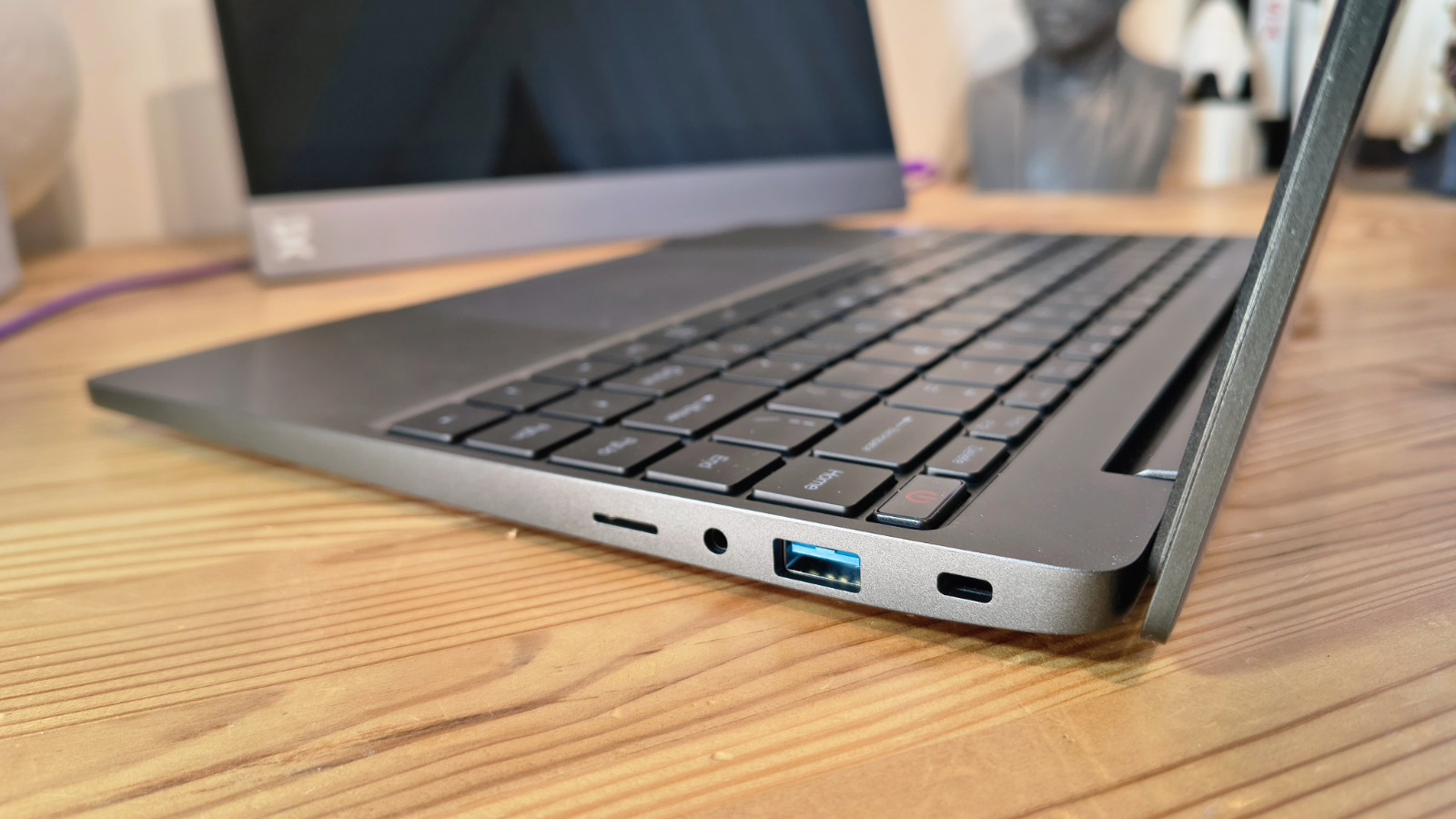
- Nice build quality
- High-res screen
- Upgradable
- No biometrics
Considering how cheap the CoreBook X is, the quality of construction is impressive. But it’s mostly plastic on the inner surface and only metal on the underside and outer lid, connected to a more rigid internal chassis.
A fourteen-inch 3:2 ratio IPS display with a 2160×1440 resolution can be useful if you need to see large documents or spreadsheets. What’s slightly odd about the chosen panel is that it’s not as saturated as some IPS displays I’ve seen, and at the higher brightness settings, it can appear a little washed out. And, because of the aspect, watching TV or file content results in large black bars at the top and bottom of the presentation.
The keyboard uses the full width of the laptop, although it doesn’t manage to find room for a numeric pad, and the touchpad is one of those unfortunate flexible click varieties. I wasn’t expecting much from either, but the keyboard works well enough.
If possible, I would like to see inside laptops to determine what upgrade options are available.
That was a more complicated exercise than it initially looked, even if you can get to the unused SODIMM memory slot merely by removing a plate held in place by two screws.
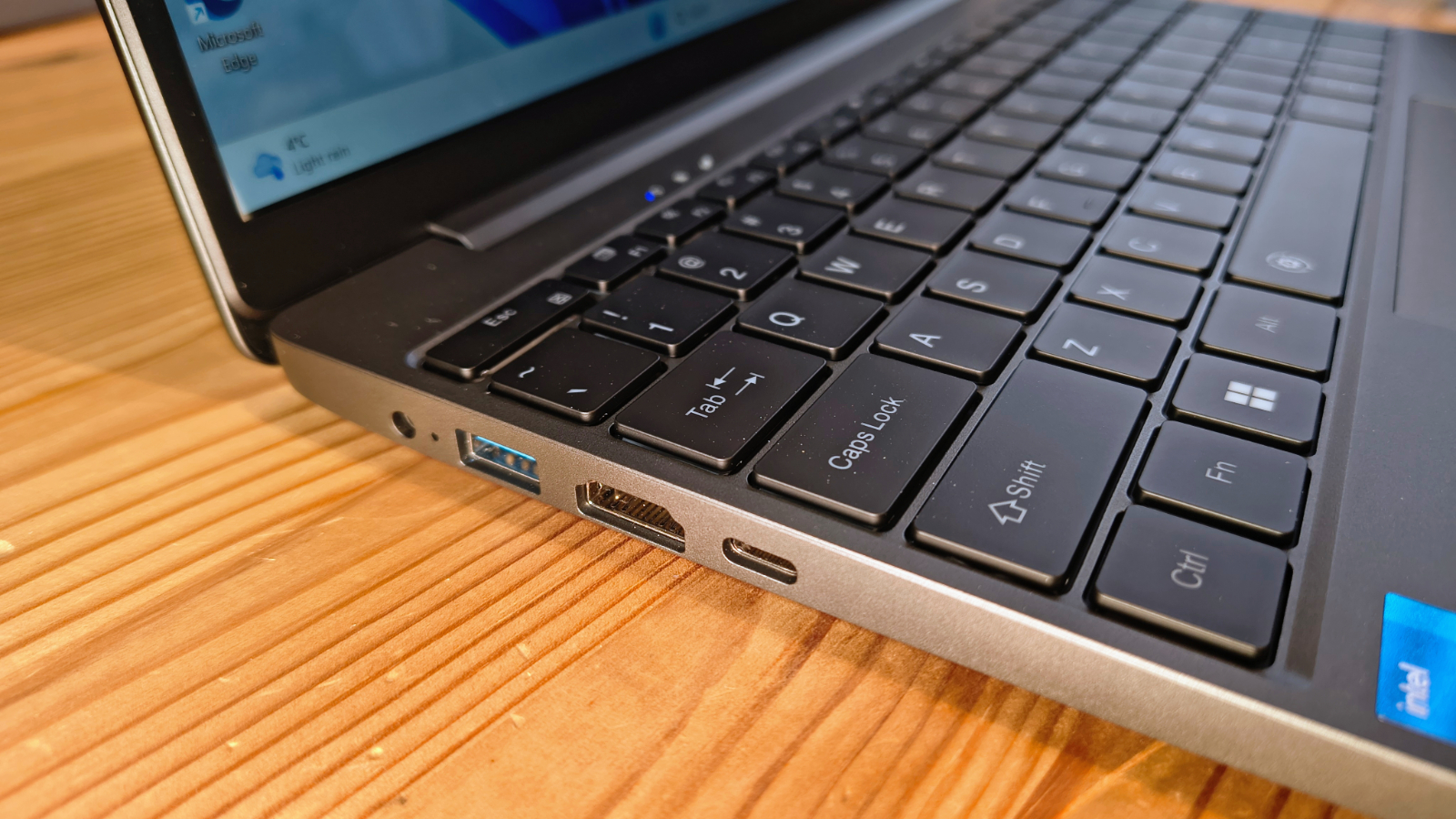
To remove the underside involves nine visible screws, one of which was underneath a QA sticker. With these off, the underside still wouldn’t release until I discovered a further two screws hidden under the rear rubber feet.
Hidden screws aren’t exceptionally customer friendly, but if you do remove them, you can get to both memory slots and the M.2 2280 NVMe drive. I didn’t see an M.2 WiFi module, but it might be on the other side of the motherboard that I wasn’t keen to remove.
While it might involve removing the back of the CoreBook X, upgrades are at least possible on this machine, though there may be negative battery life impacts of having lots of memory and a higher capacity NVMe drive.
From a business perspective, however, there is a significant pachyderm in this room.
Like the FreeBook and Hi10 Max, it lacks any security biometrics, making it less than ideal for business users. You could add a security dongle, but that undermines the low-cost logic of this device.
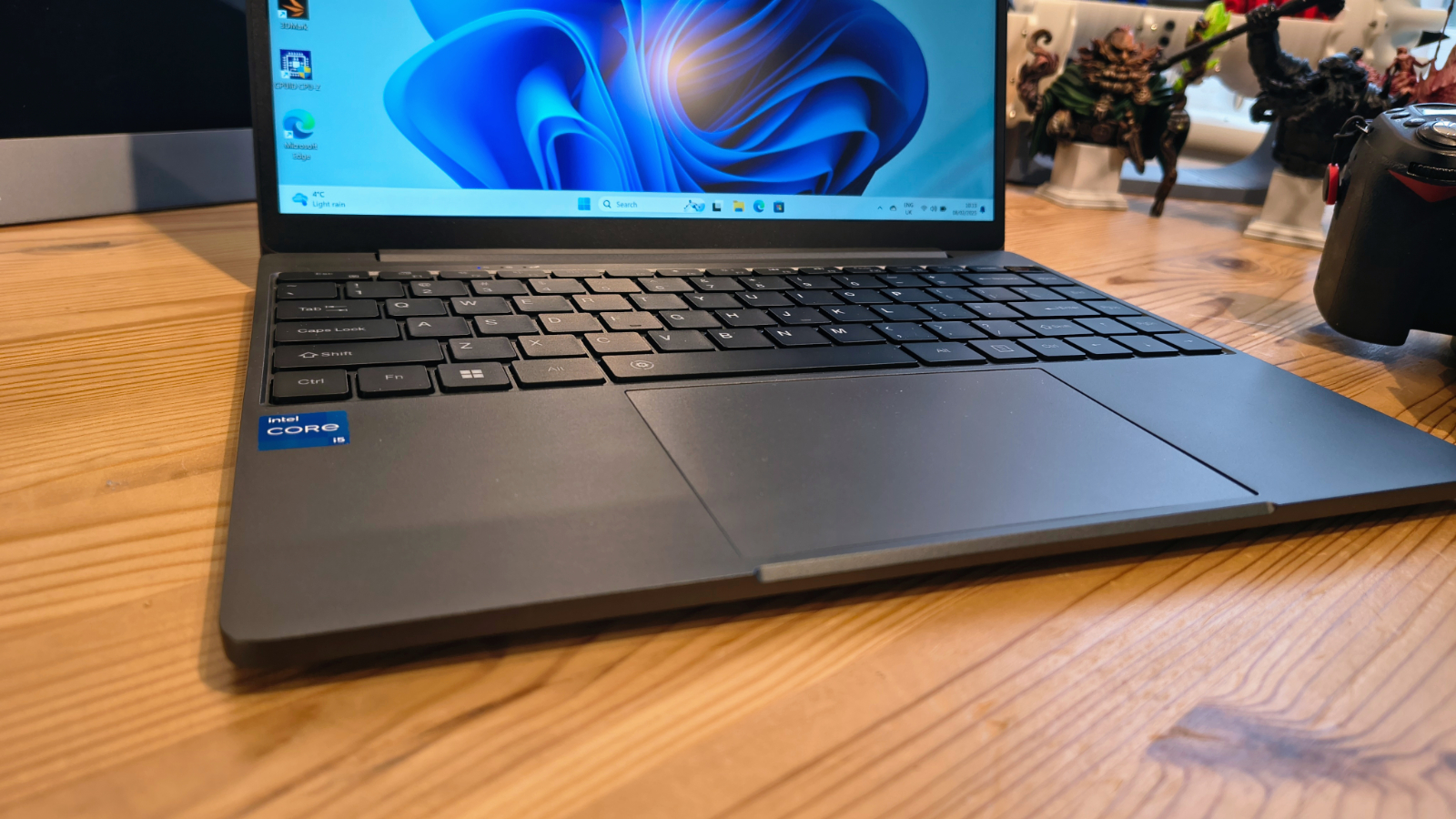
- Design: 3 / 5
Chuwi CoreBook X: Hardware
- Intel Core i5-12450H Processor
- DDR4 Memory
- 28 PCIe lanes
When you’ve seen plenty of entirely lacklustre laptops using silicon like the Intel N100 and N300, when something inexpensive comes along with an actual i5-rated CPU, it should be some cause for celebration.
However, the Intel Core i5-12450H is more of a placeholder than something that will make the CoreBook X special, mostly because it is isolated from delivering its full potential in this machine.
Looking at the specifications of this Alder Lake-era chip, it sports eight cores split evenly between performance and efficiency, a base power of 45W that can be elevated to 95W, and a baseline clock of 2GHz with the ability to Turbo up to 4.4GHz for short periods of time.
However, burst performance like that isn't ideal if you are running on battery power, as you may be with this machine.
That’s the first issue; the second is that it uses DDR4 memory, not DDR5. As I’ve already talked about and will come back to in the benchmarks, the lack of bandwidth in this system is an issue that DDR5 might have mitigated.
The third issue is the massive underutilisation of the PCIe lanes on this system in a way that makes little sense.
The Intel Core i5-12450H has PCIe 4.0 lanes, a chipset with PCI 3.0 and a total of 28 lanes to play with. It also has the option for Thunderbolt.
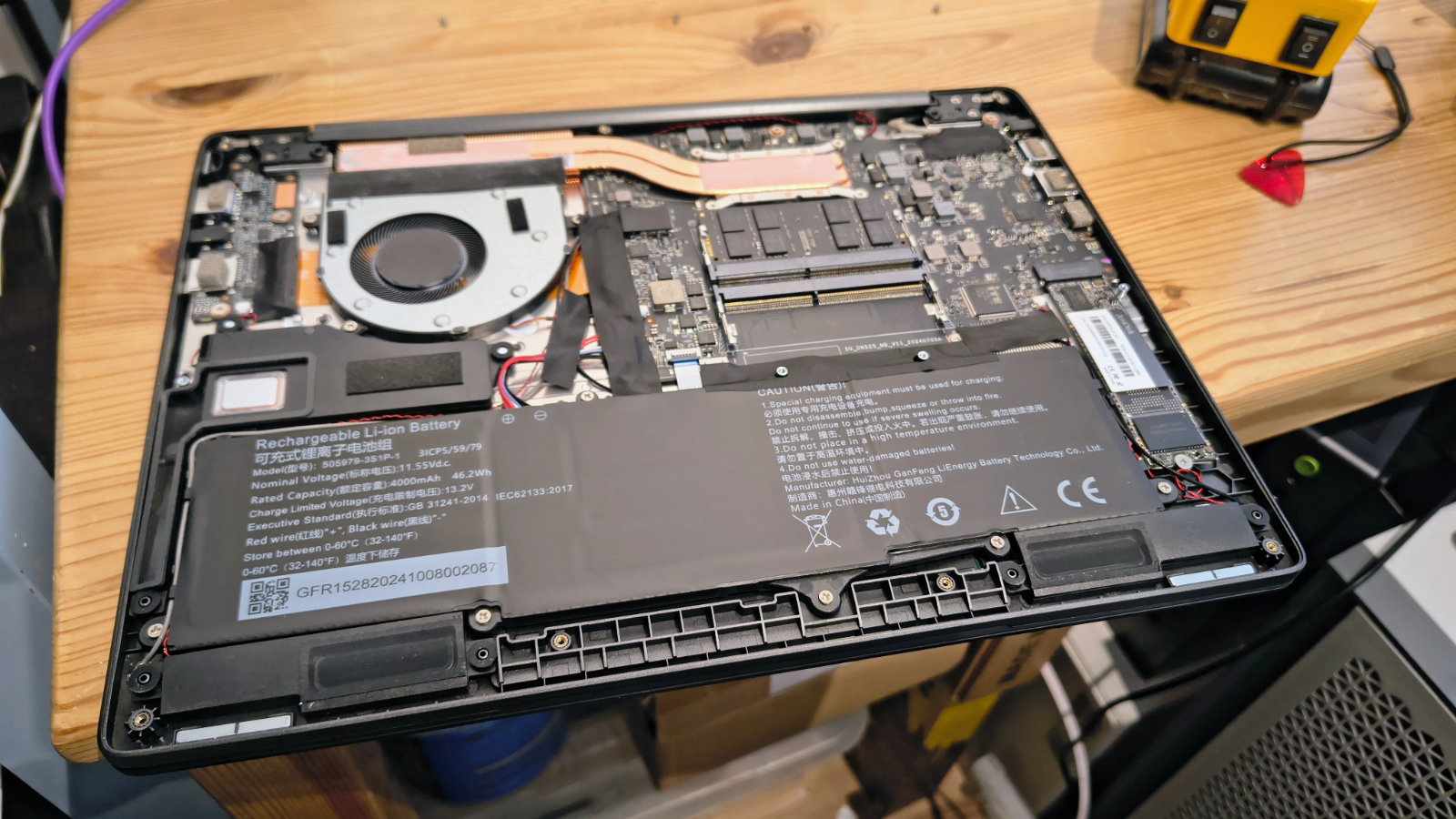
With so much PCIe bandwidth to splash, the collection of ports on this machine is disturbingly limited; there are only three USB ports, and they are all USB 3.2 Gen 1 spec.
That’s the equivalent of less than two PCIe 3.0 lanes, and the other twenty-six lanes are reserved for one NVMe drive, which can use a maximum of four, and the WiFi adapter might use two. Therefore, this system probably has PCIe lanes that remain forever unused.
The entire USB scenario on this hardware frustrated me so much that I started researching other machines that use the Core i5-12450H chip and discovered a disturbing correlation.
Randomly, I found a range of laptops that use the same platform, and these neatly fell into two camps. Either they had USB 3.2 Gen 2, or they had, like the CoreBook X, only USB 3.2 Gen 1 ports.
What divided them most noticeably was price, with the ones costing $500 and more having the better ports, and those in the prices below that getting only Gen 1 ports.
It’s entirely a guess on my part, but it looks like Intel created a low-cost template for the Core i5-12450H that didn’t include the option for third-party USB drivers, and the CoreBook X used that scheme.
The end result is a machine that looks like a bargain until you look deeper and discover that it has been tactically kiboshed.
- Hardware: 2.5 / 5

Chuwi CoreBook X: Performance
Laptops | Header Cell - Column 1 | Chuwi CoreBook X | Asus Expertbook |
|---|---|---|---|
CPU | Row 0 - Cell 1 | Intel Core i5-12450H | Intel Core Ultra 5 226V |
Cores/Threads | Row 1 - Cell 1 | 8C/12T | 8C/8T |
TPD | Row 2 - Cell 1 | 45W | 17W |
RAM | Row 3 - Cell 1 | 16GB DDR4 (1x 16GB) | 16GB DDR5 (8x 2GB) |
SSD | Row 4 - Cell 1 | 512GB AirDisk SSD | 512 GB Samsung MZVL8512HELU |
Graphics | Row 5 - Cell 1 | 12th Gen UHD Graphics | Intel Arc GPU |
NPU | Row 6 - Cell 1 | N/A | Intel NPU (40 TOPS) |
3DMark | WildLife | 5,082 | 13,247 |
| Row 8 - Cell 0 | FireStrike | 1884 | 6273 |
| Row 9 - Cell 0 | TimeSpy | 772 | 3047 |
| Row 10 - Cell 0 | Steel Nomad.L | 564 | 1908 |
CineBench23 | Single | 1553 | 1760 |
| Row 12 - Cell 0 | Multi | 6476 | 8390 |
| Row 13 - Cell 0 | Ratio | 4.17 | 4.77 |
CineBench24 | Single | 82 | 113 |
| Row 15 - Cell 0 | Multi | 312 | 520 |
| Row 16 - Cell 0 | Ratio | 3.8 | 4.59 |
GeekBench 6 | Single | 2205 | 2543 |
| Row 18 - Cell 0 | Multi | 6673 | 9881 |
| Row 19 - Cell 0 | OpenCL | 7840 | 25163 |
| Row 20 - Cell 0 | Vulkan | 9307 | 27541 |
CrystalDIsk | Read MB/s | 3215 | 5035 |
| Row 22 - Cell 0 | Write MB/s | 2397 | 2804 |
PCMark 10 | Office | 4884 | 6137 |
| Row 24 - Cell 0 | Battery | 7h 1m | 18h 18m |
Battery | Whr | 46.2 | 50 |
WEI | Score | 7.8 | 8.3 |
The problem with using older silicon, especially with respect to Intel, is that the pace of development overtook some chips more rapidly than others.
During the release of the Intel mobile gen 10, 11, and 12 parts, Intel struggled with making fabrication below 10nm work for its chips, while AMD had no such issues.
Intel has since resolved some of those limitations and new Core Ultra parts are much more power-efficient as a result.
In these benchmark results, I’ve set out to present why the mobile Gen 12 parts weren’t that wonderful and why Intel is happy to sell them off cheaply to laptop makers.
The first hurdle the Intel Core i5-12450H hits in these tests is graphical problems since the UHD Graphics core doesn’t compare well with the current ARC graphics.
What’s genuinely confusing for reviewers is that Intel describes the GPU in this package as the Intel® UHD Graphics for 12th Gen Intel® Processors, when it’s not truly a UHD series GPU, but an Xe Architecture GPU with 80 Execution units. It’s not the 96 EU that the better Xe chips get, but at least it is not an actual Intel UHD GPU.
The Xe and then ARC first superseded UHD Graphics, so it’s emotionally connected to a time when Intel started to care about graphics performance, but it’s still something of a slug in this context. However, the numbers shown here aren’t all Intel’s fault, as the Chuwi engineers decided to make the CoreBook X as inexpensive as possible and went with DDR4 memory.
The Intel Core i5-12450H does support DDR5, but in this machine, it’s a single stick of DDR4 and all the limited memory bandwidth that implies.
In the review machine was a single 16GB stick of Samsung Rank 2 3200Hz DDR4, and you could add another one of these easily. However, there are no memory controls in the BIOS, so whether this would activate a dual-channel mode is unclear, and I didn’t have any DDR4 spare to test that theory.
As the numbers shout from the highest mountains, this system is bandwidth-limited. It doesn’t multitask well (and neither does the Core Ultra 5 226V), and it’s not a great choice for graphics.
But the killer for me is the poor power efficiency, which Intel addressed with the Core Ultra 5 226V. With almost the same battery capacity, the running time of 7 hours doesn’t match the Asus Expertbook’s over 18 hours or even deliver half.
It’s worth saying that the Asus Expertbook was triple the price of the Chuwi CoreBook X, so the two can be compared in terms of what they deliver for each dollar.
Being unable to complete a working day without a recharge is problematic if you work away from the office and do not always have power available.
If that’s not an issue, then the CoreBook X is substantially better than an Intel N100-powered machine, like the Chuwi Hi10 Max 2-in-1 Tablet or Chuwi FreeBook N100.
However, with the internal storage not easily accessible and memory capped at 32GB, you might outgrow the CoreBook X quickly.
- Performance: 3 / 5
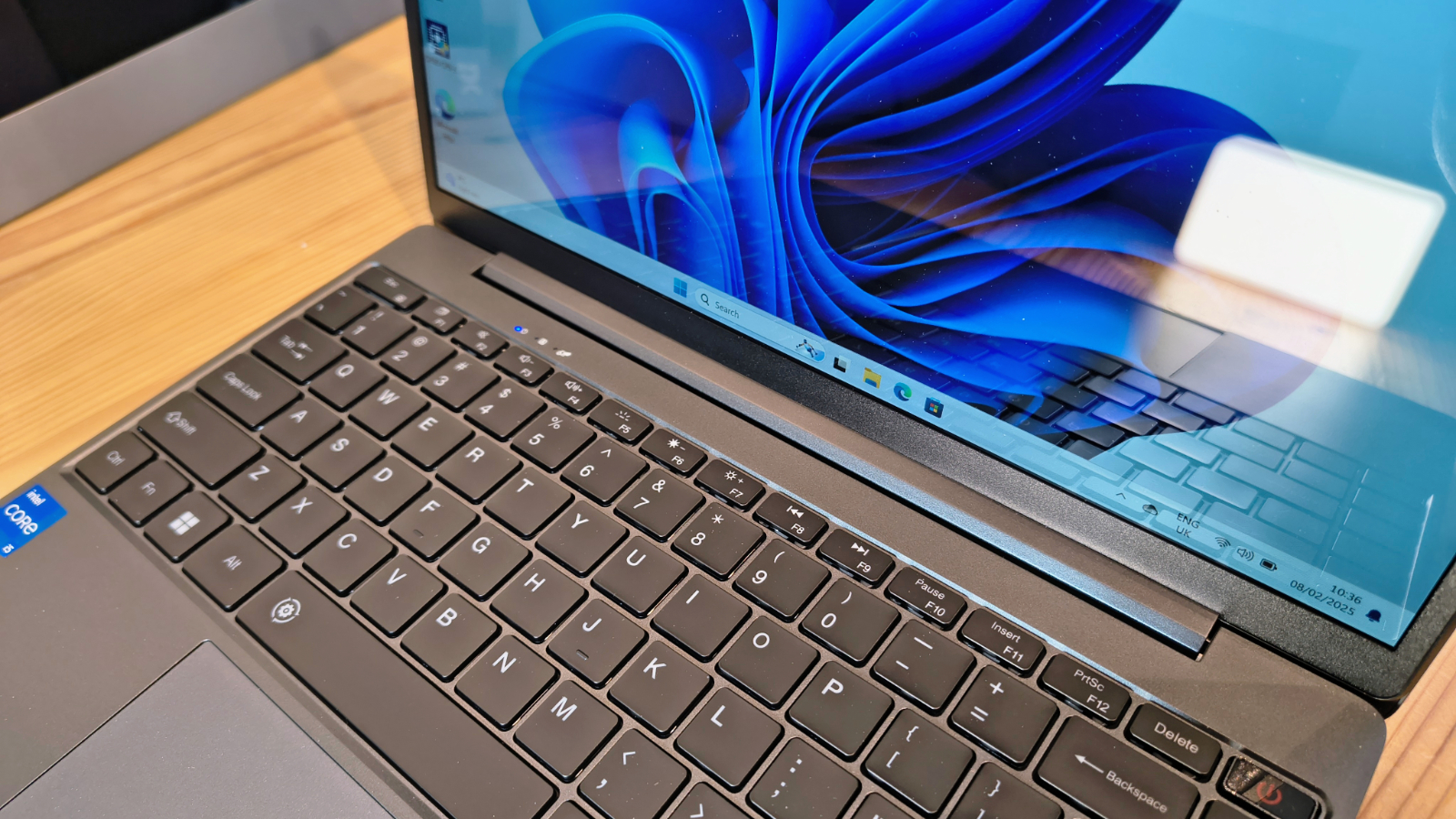
Chuwi CoreBook X: Final verdict
The CoreBook X's build quality is decent, especially considering its price. If you aren’t expecting to game or need more than 512GB of storage or all-day battery life, it can be a workable laptop.
However, the Intel i5 processor's functionality has been hampered by poor memory choice and underutilisation of its PCIe lanes.
Chuwi’s failure to include one USB 3.2 Gen 2 port for external storage is dire when the bandwidth exists for dozens, along with Thunderbolt, is breathtakingly bad.
The thinking here is that you will see the low price and pass over this machine’s numerous limitations rather than find something with better ports and storage expansion.
I'm not sure that is a good idea, as the CoreBook X isn’t a machine you can enhance with a docking station to resolve missing ports.
The price is excellent up to the point where you need more space or USB ports, and then it’s money you could have spent on something better.
Should you buy a Chuwi CoreBook X?
Value | Good build quality for the price. | 3/5 |
Design | Well made, large screen, HDMI out, but no biometrics. | 3/5 |
Hardware | 12th Gen Core i5 with DDR4, only 512GB of storage, and many unused PCIe lanes | 2.5/5 |
Performance | Better than the FreeBook N100, but battery life and video performance are poor. | 2.5/5 |
Overall | Affordable system for general tasks, but the battery life can’t last a working day, and the port selection is junk. | 3/5 |
Buy it if...
You need a low cost Windows 11 machine
The best aspect of the CoreBook X is its price; considering the build quality and screen size, it looks like a bargain. However, there is no ‘free lunch’ with this machine, and it does have some sizable limitations that explain the pricing.
Don't Buy it if...
You expect all-day battery life
In a continuous test, the CoreBook X didn’t last for a full working day, and that’s with the screen brightness turned down. Admittedly, people typically won’t work without a break, but if you often work past eight hours, you could run out of battery power.
You use external SSDs
The lack of a Gen 2 USB port means the fastest file transfers from the Chuwi CoreBook X can achieve is capped at 500mb/s. Using 1,000mb/s rated external SSDs or even faster options won’t operate to their full potential.
For more options, we've reviewed the best business laptops on the market right now.
Mark is an expert on 3D printers, drones and phones. He also covers storage, including SSDs, NAS drives and portable hard drives. He started writing in 1986 and has contributed to MicroMart, PC Format, 3D World, among others.
You must confirm your public display name before commenting
Please logout and then login again, you will then be prompted to enter your display name.
